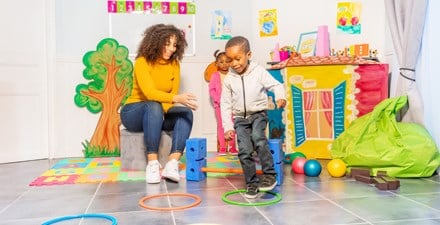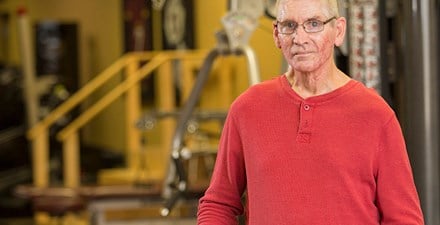Physical Therapy Guide to Cerebral Palsy
Cerebral palsy is a term that describes a group of disorders affecting movement and posture. CP is caused by injury to the brain that occurs before, during, or up to two years after birth. These injuries can include infection, stroke, trauma, or loss of oxygen. Damage to the brain does not get worse after the initial injury. However, the ability to do some everyday activities may worsen as a person grows.
People with CP may have differences in how they see, hear, perceive sensation, think, or communicate. They also may have seizures. Difficulties may range from mild to severe.
CP affects around three in every 1,000 infants born in the United States. The number of children diagnosed with CP has decreased in recent years. Improved medical care before and after birth has lowered this number.5 The average life expectancy of adults with CP has increased as well. People with CP can benefit from physical therapy during all stages of their lives.
Physical therapists are experts in helping people with CP improve their physical functions. They help them stay active, healthy, and perform daily tasks like walking, using a wheelchair, and moving to and from a wheelchair to a bathtub, bed, or car. Physical therapists also help children and families get equipment to support them in participating in school, the community and other experiences.
Physical therapists are movement experts. They improve quality of life through hands-on care, patient education, and prescribed movement. You can contact a physical therapist directly for an evaluation. To find a physical therapist in your area, visit Find a PT.
What Is Cerebral Palsy?
Cerebral palsy is a broad term. It is caused by an injury to the developing brain. CP describes the effects of that injury on the development of motor skills (movements). There are several types of CP. They are named by what body parts are affected and how movement is different.
Body areas affected:
- Quadriplegia: Affects both arms and legs, the neck, and the trunk.
- Diplegia: Affects both legs (the most common form) or both arms (less common).
- Hemiplegia: Affects just one side of the body.
- Monoplegia: Affects just one limb. This type is rare.
Types of movement:
- Spastic CP: Muscle stiffness and increasing tension can occur with movement. Spastic CP can also limit or change movement.
- Ataxic CP: Problems with balance and coordination throughout the body.
- Dyskinetic CP: Unpredictable changes in muscle tone and movement creates an unstable posture.
- Mixed CP: A combination of the spastic, dyskinetic, or ataxic movement problems.
Signs and Symptoms
Cerebral palsy looks different in each person. Signs can appear when a baby is just a few months old. Usually, parents notice symptoms before a child turns two. Early signs may include.
- Not being able to hold up their head like other babies the same age.
- Having trouble reaching with their arms.
- Difficulty rolling over, sitting, crawling, or walking.
Symptoms of CP related to movement can include:
- Tight muscles that worsen with stress, illness, or over time.
- Tight joints that do not bend or stretch all the way. This symptom occurs especially in the hands, elbows, hips, knees, or ankles.
- Muscle weakness or a decline in movements the child had already been doing.
- Slower movement compared with other children.
- Lesser movement of the legs, arms, trunk, or neck.
- Lack of coordination.
- "Floppy" muscles, especially in the neck or trunk.
- Muscle tremors or uncontrolled muscle activity.
Other symptoms of CP can include:
- Trouble speaking or being understood.
- Learning disorders (even if your child has normal intelligence).
- Vision problems.
- Hearing problems.
- Seizures.
- Joint pain often caused by tight muscles or poor posture.
- Decreased muscle strength or coordination of the mouth. This leads to problems eating and/or increased drooling.
- Constipation.
- Difficulty holding urine.
- Slower-than-normal growth.
How Is It Diagnosed?
A child's doctor may notice a delay in movement and refer them to a physical therapist. If a child sees a physical therapist first and they suspect CP, they may refer you to the child's pediatrician for a diagnosis.
Your child's physical therapist will conduct a medical history. They will ask questions about the mother's pregnancy, the birth, and the general health of the child. They also will ask about your concerns. As part of a thorough evaluation, your physical therapist will:
- Observe the child in different positions to assess movement patterns.
- Conduct a hands-on assessment of the child's muscle tone, strength, flexibility, and reflexes.
- Determine how well the child can sit, stand, or grasp objects (developmental milestones).
Your child's physical therapist will work together with your child's doctor, who may order further tests based on the physical therapist’s evaluation. These could include blood work or imaging scans (MRI or CT) needed to diagnose cerebral palsy.
How Can a Physical Therapist Help?
A physical therapist is a valuable health and fitness partner for anyone with CP. Physical therapists help people with CP gain strength and movement to function at their best through all stages of life. For people with CP, physical therapy focuses on fun, function, fitness, family, friends, and future (the six F-words of child development).
Physical therapists provide care at different stages of development. They tailor care to the unique needs of each person. Physical therapists work with other health care providers (doctors, speech/language therapists, or occupational therapists) to address needs as treatment priorities change. They also collaborate with teachers, doctors, and equipment providers for an effective team approach.
Physical Therapy in the Early Years: Birth to Age 4
Physical therapists help caregivers support their child's motor development. They provide hands-on training for positioning, movement, feeding, play, and self-calming. Your physical therapist will work with you to set goals for your child. They also will suggest ways to encourage development of movement, communication, hearing, vision, and play skills. Young children learn many skills through play and social interaction. Your child's physical therapist will tailor a program of fun play activities that match your child's specific needs and your family’s priorities. The goals of the program are to improve strength, movement, and function. At this age, children usually receive physical therapy at home, in a day care center, at an outpatient clinic, or a combination of these. Your physical therapist will work with you to update the treatment program as your child develops.
Physical Therapy in the School Years: Ages 5 to 18
Physical therapists train caregivers to help a child with CP achieve functional goals and access their community. Physical therapy promotes the highest quality of life through all stages of development. Your child’s treatment plan and goals will change as they age and their preferences or priorities change. Preschool and school bring new opportunities and challenges for your child to move within new settings and to embrace new roles each year. At this stage, children have growth spurts and require adjustments to their physical therapy program. They also may need an adjustment to the equipment that supports them. A child may receive physical therapy at school, in the community, or both, depending on their and their family's needs. School-based physical therapy focuses on giving your child the best possible learning environment. This includes making changes to the classroom to better enable learning and access and to maximize participation. The APTA Academy of Pediatric Physical Therapy’s fact sheet provides an overview of school-based physical therapy under the Individuals with Disabilities Education Act.
Your child's physical therapist will encourage mobility and fitness. They also will help your child manage any muscle or joint pain. Physical therapists recommend braces and other helpful equipment to maintain health and function. Physical therapists also teach parents and help people with CP develop strategies for self-care, daily routines, and being social and active. This will help you and your child plan for school and future careers.
The teen years are the stage of life to form lifelong healthy habits. Developing a personal fitness program may improve health and function for people with CP for the rest of their lives. Children with CP are at a higher risk of not getting enough physical activity. This can lead to weight issues and other medical changes. These issues can impact quality of life for the child and their caregivers. Physical therapy for teens with CP will focus on preventing problems with posture and joint mobility. Physical therapists are skilled in developing personalized exercise programs. They consider each person's condition, interests, strengths, and abilities. A physical therapist might recommend sports such as bowling, swimming, cycling, volleyball, tennis, or basketball. These activities can promote physical fitness and participation in social events with peers.
Physical Therapy in Adulthood: Age 18+
Many people with CP live highly functional lives as adults. They often enjoy careers and families. Physical therapy for adults with CP often focuses on:
- Managing pain.
- Conserving energy.
- Use of helpful adaptive equipment.
- Making changes to their environment to promote independence at work, at home, and in the community.
Physical therapists may form long-term relationships with their clients to help manage concerns and maintain health. Adults with CP often have muscle and joint pain in adulthood. Physical therapists can prescribe exercise routines that enable them to stay strong and reduce joint issues. Physical therapists are skilled partners at addressing personal goals.
What Kind of Physical Therapist Do I Need?
All physical therapists are prepared through education and experience to treat patients with cerebral palsy. You may want to consider:
- A physical therapist who has experience treating people with CP.
- A physical therapist who focuses on treating infants and children.
- A physical therapist who is a board-certified clinical specialist or who has completed training in pediatric or neurologic physical therapy. This physical therapist has advanced knowledge, experience, and skills that may apply to your condition.
You can search for physical therapists near you who meet these criteria by using Find a PT, provided by the American Physical Therapy Association.
General tips when you're looking for a physical therapist (or any other health care provider):
- Get recommendations from family, friends, or other health care providers.
- Ask about the physical therapists' experience in helping people who have cerebral palsy.
- Be prepared to describe symptoms in as much detail as possible, identify what makes the symptoms worse or better, and discuss your goals.
The Academy of Pediatric Physical Therapy contributed to this consumer resource. It is for informational purposes only and is not intended to represent the position of APTA Pediatrics.
Additional Resources
- Cerebral Palsy Foundation: Understanding Cerebral Palsy
- American Academy for Cerebral Palsy and Developmental: Early Detection of Cerebral Palsy
Further Reading
Gonzalez NA, Sanivarapu RR, Osman U, et al. Physical Therapy Interventions in Children With Cerebral Palsy: A Systematic Review. Cureus. 2023;15(8):e43846. Published 2023 Aug 21. Article Summary in PubMed
Das SP, Ganesh GS. Evidence-based Approach to Physical Therapy in Cerebral Palsy. Indian J Orthop. 2019;53(1):20-34. Article Summary in PubMed
Damiano DL. Rehabilitative therapies in cerebral palsy: the good, the not as good, and the possible. J Child Neurol. 2009;24(9):1200-1204. Article Summary in PubMed
The American Physical Therapy Association believes that consumers should have access to information that can:
- Help them make health care decisions
- Prepare them for a visit with their health care provider
The following articles provide some of the best scientific evidence for the treatment of cerebral palsy. The articles report recent research and give an overview of the standards of practice in the United States and internationally. The article titles link either to a PubMed* abstract of the article or to the free full text to read or bring with you to your health care provider.
CAPTE. Standards and required elements for accreditation of physical therapist programs. Available at https://www.capteonline.org/globalassets/capte-docs/2024-capte-pt-standards-required-elements.pdf. Published October, 2023. Accessed July 21, 2025
States RA, Salem Y, Krzak JJ, Godwin EM, McMulkin ML, Kaplan SL. Three-Dimensional instrumented gait analysis for children with cerebral palsy: An evidence-based clinical practice guideline. Pediatr Phys Ther. 2024;36(2):182-206. Article Summary in PubMed
Fehlings D, Agnew B, Gimeno H, Harvey A, Himmelmann K, Kin J, Mink JW, Monbaliu E, Rice J, Bohn E, Falck-Ytter Y. Pharmacological and neurosurgical management of cerebral palsy and dystonia: Clinical practice guideline update. Dev Med Child Neurol. 2024;66;1133-1147. Article Summary in PubMed
Baram M, Zuk L, Stattler T, Katz-Leurer M. The Prevalence of Bladder and Bowel Dysfunction in Children with Cerebral Palsy and its Association with Motor, Cognitive and Autonomic Function. Dev Neurorehabilitation. 2023;26(3), 155-162. Article Summary in PubMed
Faccioli S, Pagliano E, Ferrari A, Maghini C, Siani MF, Sgherri G, Cappetta G, Borelli G, Farella GM, Foscan M, Viganò M, Sghedoni S, Perazza S, Sassi S. Evidence-based management and motor rehabilitation of cerebral palsy children and adolescents: A systematic review. Frontiers in Neurology. 2023; 14:1171224. Article Summary in PubMed
Damiano DL, Longo E, de Campos AC, Forssberg H, Rauch A. Systematic review of clinical guidelines related to care of individuals with cerebral palsy as part of the World Health Organization efforts to develop a global package of interventions for rehabilitation. Archives of Physical Medicine and Rehabilitation. 2021; 102: 1764-74. Article Summary in PubMed
Jackman M, Sakzewski L, Morgan C, Boyd RN, Brennan SE, Langdon K, Toovey RAM, Greaves S, Thorley M, Novak I. Interventions to improve physical function for children and young people with cerebral palsy: international clinical practice guideline. Developmental Medicine & Child Neurology. 2021;64(5):536-549. Article Summary in PubMed
Lennon N, Church C, Shrader MW, et al. Mobility and gait in adults with cerebral palsy: evaluating change from adolescence. Gait Posture. 2021;90:374-379. Article Summary in PubMed
Patel DR, Neelakantan M, Pandher K, Merrick J. Cerebral Palsy in children: a clinical overview. Transl Pediatr. 2020;9(Suppl 1):S125-S135. Article Summary in PubMed
Graham D, Paget SP, Wimalasundera N. Current thinking in the health care management of children with cerebral palsy. Med J Aust 2019; 210:129-35. Article Summary in PubMed
National Institute for Health and Care Excellence (NG119). Cerebral palsy in adults. https://www.nice.org.uk/guidance/ng119 Published January, 2019. Accessed June 27,2025.
Torjesen I. NICE publishes guideline on diagnosing and managing cerebral palsy in young people. BMJ 2017;356:j462. Article available on PubMed
*PubMed is a free online resource developed by the National Center for Biotechnology Information. PubMed contains millions of citations to biomedical literature, including citations in the National Library of Medicine's MEDLINE database.
Expert Review:
Jul 31, 2025
Revised:
Jul 31, 2025
Content Type: Guide
Cerebral Palsy
PT
Sandra Jean Burns
PT, DPT
You Might Also Like...
Health Tips
Tips to Select Toys for Children with Special NeedsSep 3, 2024
Play has an important role in the growth and development of children of all abilities, but it is particularly valuable for children with special needs
Podcast
Toys and Tips for Raising Children With Developmental DisabilitiesDec 9, 2021
Play is a vital part of physical therapy for children with autism, cerebral palsy, or other developmental disabilities. Two moms and bloggers discuss raising
Patient Stories
Medicare Therapy Cap Leads to More PainSep 12, 2017
A drug pump "takes the edge off of the worst of the pain," but for additional relief Nate relies on treatment from a physical therapist.



